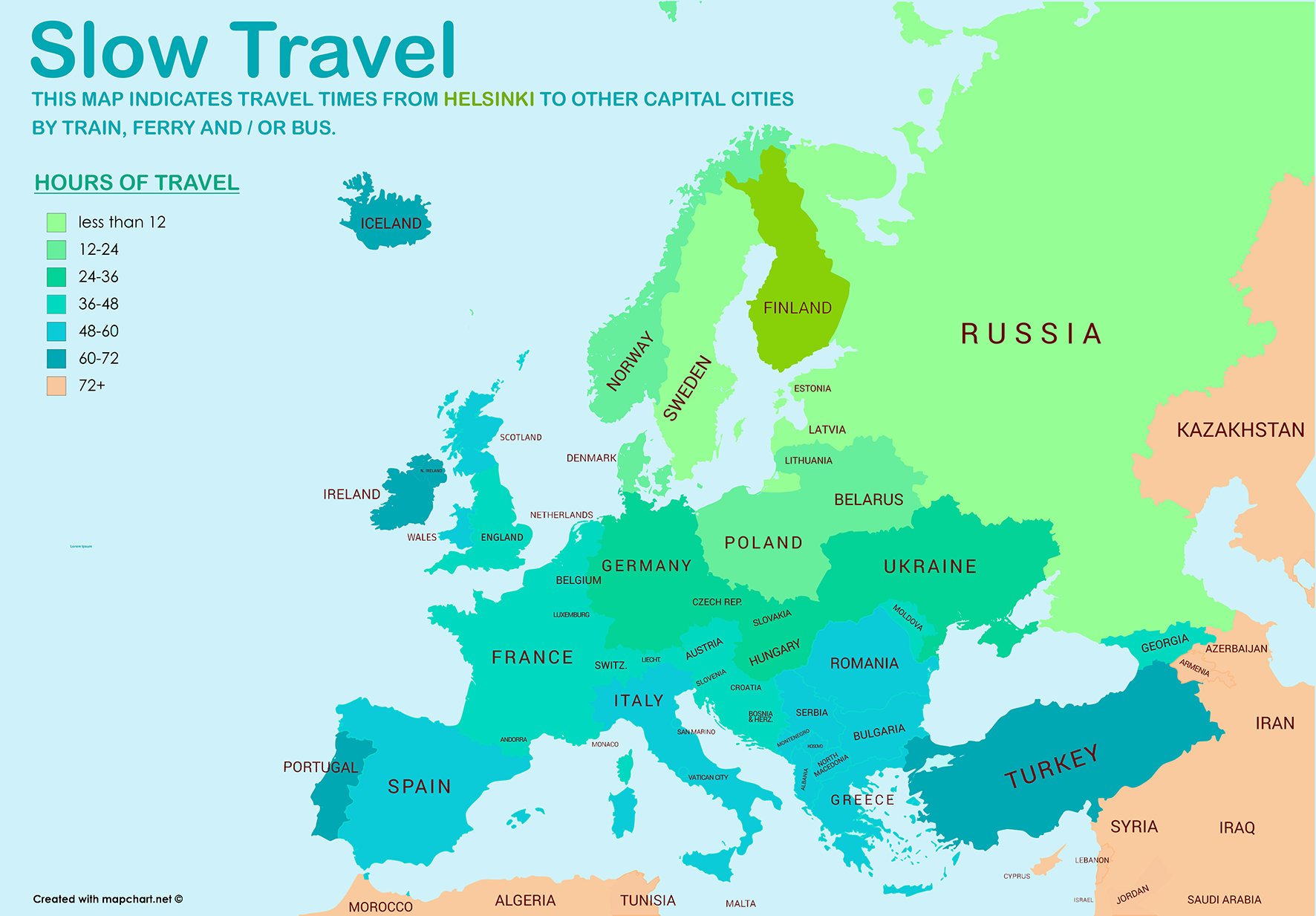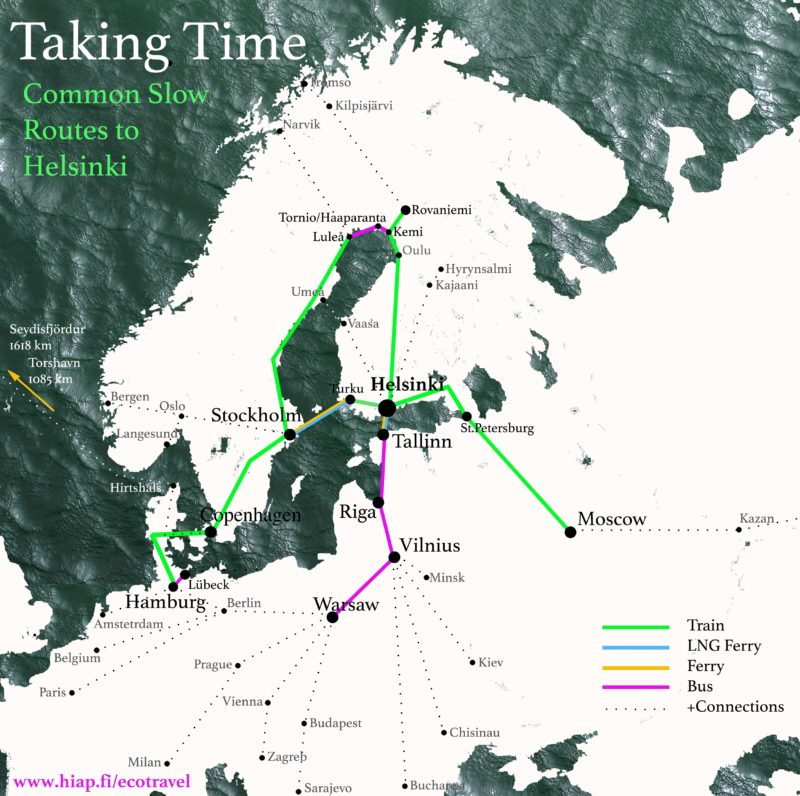Ecological Travel
How to get to Helsinki?
Travel related to art and research is a notable source of carbon dioxide emissions. To lessen the carbon footprint of our movements HIAP encourages travelling by ecological means and avoiding flying and private car usage whenever possible. Here are some tips for travelling ecologically to HIAP (and beyond!).

COMMON ROUTES
Here are the common slow travel routes that are used to travel to Helsinki by land/sea:
TIP: The most ecological route may not be the most affordable. The earlier you book your trip, the better your chances are to find affordable tickets.

TRAVELLING FROM THE…
SOUTH
Warsaw-Vilnius-Tallinn-Helsinki
The bus Warsaw-Vilnius-Tallinn can be booked from Ecolines or Lux Express.
Schedules and tickets for the ferry Tallinn-Helsinki are available from Eckeroline, Tallink-Silja** or Viking Line.
**Tip: The lowest emissions boat that operates between Helsinki and Tallinn is the liquid natural gas (LNG) Ferries the Tallik Megastar or the Tallik MyStar.
The carbon footprint of this total trip with a standard ferry is 86 kg CO2eq. Using the LNG Ferry the emissions are 80 kg CO2eq. The air travel between Warsaw and Helsinki results in 300 kg CO2eq.
Finnlines who operates the ferry between Helsinki-Lübeck will have new LNG ferries in their fleet as soon as 2021. Check the type of ferry when you are booking to make the most ecological choice!
WEST
Hamburg-Copenhagen-Stockholm-Turku-Helsinki
The train Hamburg-Copenhagen can be booked via DBS or Deutsche Bahn.
The train Copenhagen-Stockholm via SJ.
The ferry Stockholm-Turku booked via Tallink-Silja or Viking Line**.
The train from Turku-Helsinki via VR.
**Tip:The lowest emissions boat that operates between Stockholm and Turku is the Viking Grace and the MS Viking Glory.
The carbon footprint of this trip with a standard ferry is 54 kg CO2eq, with the LNG (liquid natural gas) ferry the Viking grace it is 33 kg C02eq. The air travel between Hamburg and Helsinki results in 382 kg CO2eq.
Hamburg-Lübeck (Travemünde)-Helsinki
The Bus Hamburg-Lübeck can be booked from Deutsche Bahn.
Schedules and tickets for the ferry Lübeck-Helsinki can be found at Finnlines.
The carbon footprint of this total trip is 352kg CO2eq. These calculations are for a diesel Ropax ferry which on average emits .3kg CO2e/km (information from VTT LIpasto). The air travel between Hamburg and Helsinki results in 382 kg CO2e.
Stockholm-Luleå-Tornio/Haaparanta-Kemi-Helsinki
The train Stockholm-Luleå via SJ.
The bus Luleå-Tornio/Haaparanta via Kiruna Stadstrafik or Eskelinen.
The bus Tornio/Haaparanta-Kemi via North European Bus Tours Ky.
The train from Kemi-Helsinki via VR.
The carbon footprint of this trip 16 kg CO2eq. The air travel between Stockholm and Helsinki results in 226 kg CO2eq.
Umeå-Vaasa-Helsinki
The Ferry Umeå-Vaasa can be booked through Wasaline.
The Train Vaasa-Helsinki via VR.
The carbon footprint of this trip 29 kg CO2eq (based on the carbon data for a diesel ferry). The air travel between Umeå and Helsinki results in 155 kg CO2eq.
Seyðisfjörður-Hirtshals-Frederikshavn-Gothenburg-Stockholm-Helsinki
The Ferry Seyðisfjörður-Hirtshals can be booked through Smyril Line
The Train Hirtshals-Frederikshavn can be booked via Nordjyllands Trafikselskab
The Ferry Frederikshavn-Gothenburg via Stena Line
Train Gothenburg-Stockholm with Swedish Railways
From Stockholm you can travel to Helsinki via train or ferry see routes above
The carbon footprint of this trip 307.7 kg CO2eq (based on the carbon data for the LNG ferry between Stockholm and Helsinki) . The air travel between Egilsstaðir to Helsinki via Reykjavik results in 1509 kg CO2eq.
The Long Distance Residency Project travelled to Iceland via land and sea in 2023. Here you can learn more about the project.
NORTH
Rovaniemi-Helsinki
The recommendation is to travel by train, the journey takes on average 8 hours and prices can range from 34€-80€. For tickets and timetables see the VR Website.
There are also bus connections by OnniBus and Matkahuolto.
The carbon footprint of this trip by train is 1 kg CO2eq, by bus 59 CO2 eq. The air travel between Rovaniemi and Helsinki results in 231 kg CO2eq.
Narvik-Luleå-Tornio/Haaparanta-Kemi-Helsinki
Train Narvik-Luleå via Swedish Railways
The bus Luleå-Tornio/Haaparanta via Kiruna Stadstrafik or Eskelinen.
The bus Tornio/Haaparanta-Kemi via North European Bus Tours Ky.
The train from Kemi-Helsinki via VR.
The carbon footprint of this trip is 13 kg CO2eq. The air travel between Narvik and Helsinki results in 324 kg CO2eq.
Tromso-Bromsgård(Narvik)-Luleå-Tornio/Haaparnata-Kemi-Helsinki
Bus Tromso-Bromsgård(Narvik) via Troms Fylkeskommune
Train Narvik-Luleå via Swedish Railways
The bus Luleå-Tornio/Haaparanta via Kiruna Stadstrafik or Eskelinen.
The bus Tornio/Happaranta-Kemi via North European Bus Tours Ky.
The train from Kemi-Helsinki via VR.
The carbon footprint of this trip is 28kg CO2eq. The air travel between Tromso and Helsinki results in 357 kg CO2eq.
CARBON EMISSIONS
Carbon emission calculators give a rough estimate of the CO2 or CO2e (CO2 equivalent, which includes all greenhouse gas emissions that contribute to global warming) created by a certain trip and though the numbers may vary the general consensus is that modes of transportation can be ranked from most emissions to least emissions in the order plane, ferry, bus, train.
The carbon calculator* (in Finnish) used in the above calculations estimates the CO2e created by 350 km travelled with different vehicles as follows; plane = 200kg, average ferry = 60kg, LNG(Liquid Natural Gas)= 35kg, bus = 23kg and train = 1kg (based on Finnish transportation systems).
This calculator was developed by the University of Helsinki and uses VTT Lipasto calculations as their basis, with the added radiative forcing index (RFI) for flights. Helsinki city environmental services has confirmed the calculations are trustworthy.
To calculate the flight distances we have used www.distancefromto.net and for train and bus distances we have relied on the numbers supplied by Rome2rio.com.
In the cases of specific types of ferries we have used the VTT Lipasto database:
LNG ferry 18kn: .099 kg CO2e/km.
Petrol ferry 18kn: .144 kg CO2e/km
Petrol ferry 24-27kn: .282 kg CO2e/km
Petrol ferry 40kn: .461 kg CO2e/km
Diesel or Ropax 21-24 kn: .3 kg CO2e/km
We will update these numbers periodically
RESOURCES
There are many possibilities when it comes to routes and modes of transportation! Here are some resources for finding your way:
Rome2Rio is a booking site that shows multiple travel variations including flight, train, bus, ferry, rideshare or rental car and includes estimated prices, journey durations, booking details and carbon footprint.
With EcoPassenger you can compare the energy consumption, the CO2 emissions and other environmental impacts of planes, cars and trains for passenger transport along routes of your choice.
The Helsingin Sanomat has created a counter that shows you how to travel in Europe by train and how much it costs (in Finnish).
The Man in Seat Sixty-One is a comprehensive guide for train and ferry travel world wide complete with photographs of the different travel options and route guides.
Maatapitkin specialises in ecological travel to and from Finland as well as further in Europe (in Finnish).
TRAVEL STORIES
Stories and tips from artists slow/ecological travel to and from Finland:
Slow travel from Helsinki to Venice/HIAP
Slow travel through Russia – tips for the Trans-Siberian train/HIAP
Brno-Praha-Tallinn-Helsinki-Iisalmi-Hyrynsalmi-Kajaani-Helsinki-Tallinn-Praha-Brno /Mustarinda
